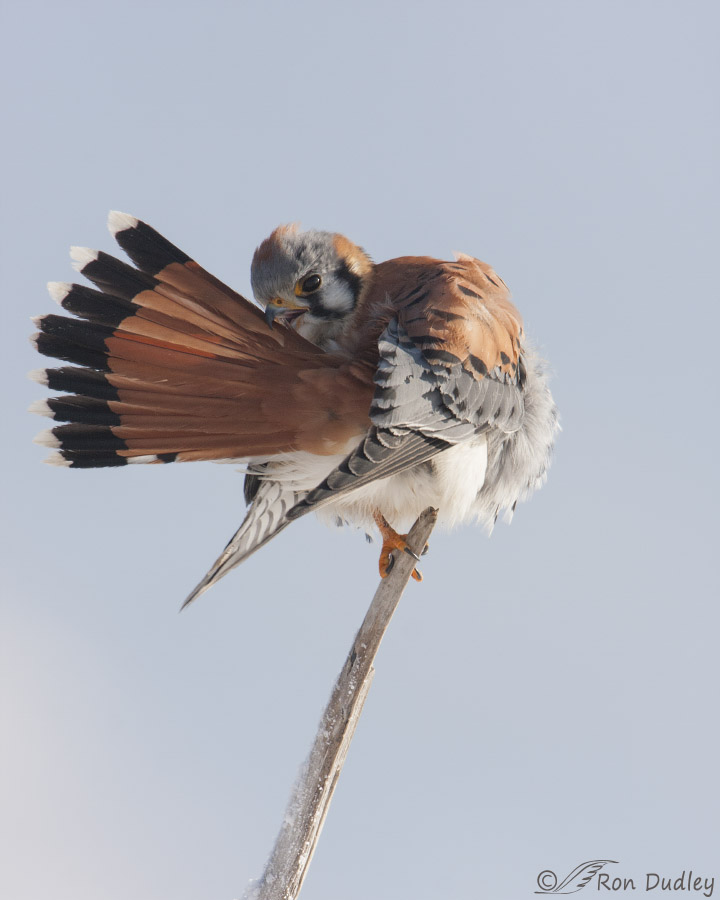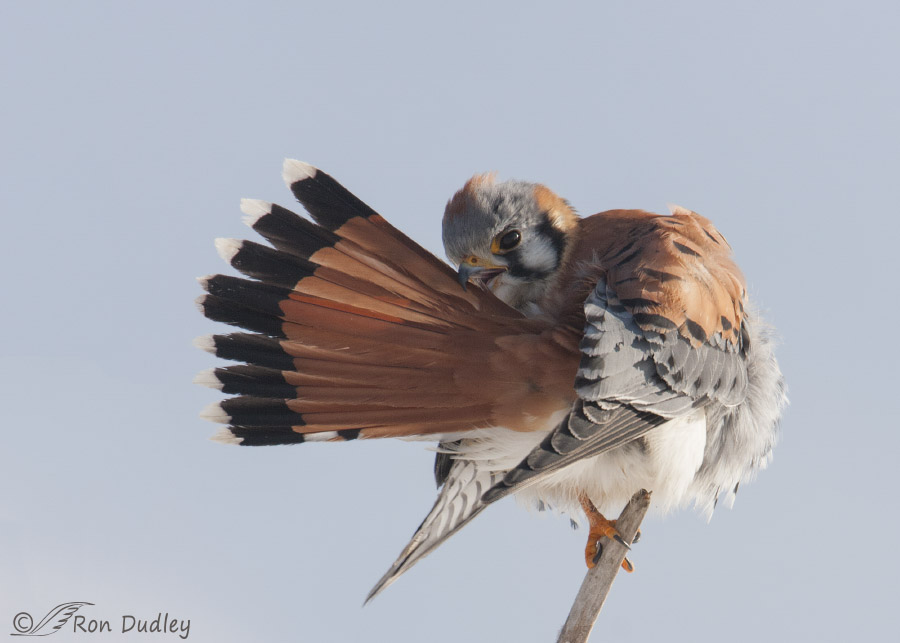This is a pose I almost never get from a kestrel.

1/800, f/10, ISO 500, Canon 40D, Canon EF 500mm f/4L IS USM + EF 1.4 Extender, not baited, set up or called in
I photographed this beautiful male kestrel at Farmington Bay way back in yesteryear, on the morning of New Years Day Eve 2008. I’ve never posted the image before because the bird is sidelit and I don’t like the composition options I’m restricted to. I was very close to the bird so I was shooting vertically while he was perched vertically but when he unexpectedly began to groom his tail he became too tight at the frame edges for pleasing composition. In hindsight I should have simply rotated my camera but in the time that would take I was afraid I’d miss that special shot so I just kept firing away.
But I’ve now determined that I like the pose and behavior so much I can live with the sidelight (especially since I do have a catch light in the eye) but I simply cannot live with this composition.

So I “cheated” and added canvas to the left side of the frame. I try very hard to resist doing this kind of manipulation of my images but this time Photoshop seduced me. I think including more of the perch with its wind-blown snow on the side has its charm but overall I prefer this second version. Another option would have been to keep the vertical composition (and more of the snowy perch) by cropping a little tighter on the right and adding canvas on the left. I might try that down the road but overall I tend to prefer horizontal compositions. Opinions may vary…
I have another image of this bird in this pose where he’s working over one of those distinctive black and white outer tail feathers (they can’t be seen here). I think I’d have liked that photo even more than this one but there’s even less light on his face and none at all in his eye. Disappointing…
Ron
Note: On those very rare occasions when I do any significant cloning to my images, including adding canvas, I always disclose what I’ve done. To me it seems misleading and dishonest not to, especially in nature photography. That said I do sometimes clone out dust spots or a few dark spots on water or even enhance an existing catch light (I never add catch lights) without disclosing.


I’ve got a shot of a flying great egret to which I added canvas on the right side of the shot. My justification went as follows: The background was a uniform dark blue-green field – as your background in this shot is a uniform sky. So adding more of the same field (actually, moving the bird 1/4″ to the right in Photoshop) allows the viewer to look at the light on the bird’s feet without being distracted by the immediate edge of the shot. Next question I asked myself, and pose here – when I add or remove shadow on part of a shot in Lightroom, I’m manipulating the image. For example, you could have manipulated the shadow on the bird’s head, neck in this image. How or to what degree is adding field a different dissembling? I grapple with this a good deal. I am interested in people’s thoughts.
I can seriously watch a raptor/bird preen for hours. I’m fascinated with it and the bird is usually in sort of a Zen while they’re putting their feathers back in order. When I try to put all those vanes together, it takes a long time using my fingers. Beaks, however, make it happen with one or two passes.
And male Kestrels are just amazing jewels! How do they do that feather thing? And yes, it would have been good for you to catch those outside tail feathers (amazing!) but the preening is a good thing.
That you “cheated” (I’m with Patty that it’s really not cheating, but I recognize the slippery slope issue, too) is not a problem for me one way or the other. In this case, the background is not the focus of this shot and I didn’t notice it at all. My focus was the gorgeous male Kestrel, background be damned 😉
Sorry, the weekend got away from me. The Mohave County Fair happened, plus payback for doing too much. DARGH!
Ron,
Have you though of keeping the same aspect ratio of the original, but cropping the image so that the same amount of sky was on both sides of the Kestrel? I believe it would improve the composition of the original, show more of the perch than the second image, and you wouldn’t have to add anything to the image that was not there. Just a thought.
I tried that, Lee. For my tastes it was much too tight on both the left and right sides.
I LOVE both of these images, but you said something that puzzles me…you claimed that you “cheated” by “adding canvas”…how can that possibly be “cheating” when the sky is actually so vast—when any and all photos shrink it so incredibly??? All you really did was restore a miniscule amount of it….How is that “cheating”…you didn’t add any elements that weren’t there…..what am I missing?
“you didn’t add any elements that weren’t there”
I believe I did add elements, Patty. I added sky that wasn’t there. That added sky and space is an element of the photo.
Where do you draw the line? If this isn’t cheating would it be if there were clouds in the added part? Ok to clone in clouds that weren’t there? Ok to add or remove distracting, unwanted birds that were back there? Remove contrails? It’s a slippery slope…
In my eyes, adding things like sky, water,and grasses would not he “cheating” because they are expansive and vast (and neutral)—unless some other element was also added …in a way, you might say cropping is cheating becsuse you are excluding things that are actually there and would otherwise be visible , but because you’ve cropped, they appear not to exist…so there!!!
Love the second shot with added canvas – and cropped so I can admire more of the beautiful pint-sized assassin.
As far as nature-photography goes, this one is certainly a venial sin. You are safe from the eternal pit of damnation into which I would happily cast baiters…
That’s one pit I’ll always be safe from. Thanks, EC.
I like the second image – with the added canvas, much better than the first. I would be very interested to see the image if you kept the vertical format and added canvas to the left. I think that would my preferred version of the image. I’m glad you posted one of my favorite birds today – I’m always very happy to see an American Kestrel.
I’m happy to see kestrels too, Susan. Hopefully with winter’s cold weather on the horizon I’ll be able to get close to a few of them again.
Ron,
I haven’t commented for some time but I have followed and read your blog daily. Work gets busy but now it is settling down and I can get back to important stuff: photography and hobbies. Work does tend to get in the way but it is necessary to by camera equipment! I think the Kestrel is a beautiful bird and love your shots. As far as photoshop, I commend you for your integrity. Adding canvas–although I have read your opinion many times–I think is certainly acceptable and not even close to the sin of calling in or baiting the birds without revealing that fact. I just love your blog and can’t wait to get back out there, especially when Farmington Bay opens again. Keep shooting, Keep blogging!
Best,
Stephen
Thank you, Stephen. Agreed – adding canvas doesn’t even approach the sin of baiting raptors!
As I was looking at your first shot, I thought to myself, “I kinda wish he had cloned in some more background next to the tail,” and bippidyboppidyboo my wish came true! 😉 I completely understand and agree with your hesitation over too much manipulation in nature photography. Still, I’m glad you picked this shot to cheat a little. You took it from awesome to awesomatious! Totally worth the crick in the neck, the back spasm, the window in the side, and the tired arms required to twist your camera around. 🙂
“bippidyboppidyboo” – I love the little phrasing surprises you often include in your comments, Marty!
I can’t take credit for this one. It’s Disney all the way (Cinderella).
I believe I’ve mentioned before that Kestrels are one of my all time favorite birds….these shots are exquisite! The added canvas in the one definitely adds to the composition…well done….and Thank you again.
Thanks very much, Steve.
I completely agree with the “nature photography” contest comment. Completely different venues. Have a great day!
Good morning Ron. Thanks again for the post to go along with my coffee.
I like the image and agree, adding the canvas makes for a much better presentation. As you know, I am not nearly as reticent as you to make “adjustments” to images to provide viewer, from my perspective, the best experience. But also, in that the image is yours, optimizing the image to your satisfaction makes for a better personal experience as well. For example, consider the various renditions of “Moonrise over Hernandez”. Adams had, in his mind,a view of how he wanted to present the image. Over time, that view changed dramatically and you can see that in the various renditions of the original “raw” file. Did he plagiarize the image? No, not at all. It was simply a different interpretation of how he perceived the original capture. There is nothing wrong with that, from my perspective and I don’t think it was necessary for Adams to explain his interpretation.
Just me and thanks for the brain tickle this morning!
Frank, when it comes to the ethics of photo manipulation in nature photography “different strokes for different folks” seems to rule the day. I just do what works best for me. Nature photography is my goal, not photo art. IMO there’s good reason why highly respected nature photography contests ban cloning and heavy-handed image manipulation…
GORGEOUS! So glad you decided to “mess with it”………:) It’s beautiful either way, BUT adding the canvas really adds to the Kestrel with the edge not so close.
I agree, Judy. Composition can make a huge difference, either way…
Exquisite little ” fan dancer”……..I enjoyed this shot very much ! Did reflection from snow on the ground fill in the side-lighting ? The bird is beautifully illuminated from every angle !
Thank you, Kris. Yes, there was light reflected by snow for this shot but during processing I also lightened the shadows a little in the RAW file.
WOW, WOW, WOW, What gorgeous shots! I am mesmerized by these images!!
Canvas, no canvas the image is spectacular! I can just imagine how difficult it was to be able to get this shot! Well done!!
Thanks, Dick. The biggest difficulty in getting this shot and others similar to it was shooting vertically. Shooting in that position out my window with my long lens is awkward and uncomfortable.